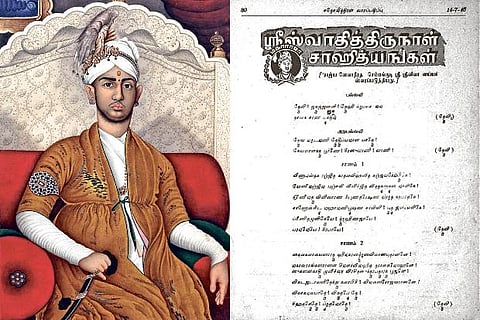

Chennai
Kings of the past did fight duels. But this was absolutely new. The king was long dead and had been dragged into a fistfight he would have never forethought.
Travancore was a very loaded state ruled by a Hindu raja with a Chera lineage. It was still a feudal set-up on the borders of a very dissimilar British-ruled Madras presidency. The rulers had a regular court where musicians, poets and artists performed. Naturally, Tamil musicians sans patrons often migrated to Travancore, supported by the art-loving royalty.
In the middle of the 19th century, Rama Varma, known as Swathi Thirunal (named after the natal star under whose influence he was born), was a progressive ruler in a state bound by rigid societal regulations. He even constructed an astronomical observatory — one of the earliest in the subcontinent. Though he sponsored musicians during his lifetime and for nearly a century later, he certainly was not considered a prolific Carnatic composer. The reason believed was as a king he did not have disciples to propagate his music.
But almost a century after he died, his compositions suspiciously began to crop up. The notations of the king’s songs were published by Semmangudi Srinivasa Iyer in Swadesamitran paper. Many musicians started adding a composition of the king in their kutcheries. A painting of the king, sponsored by the royal family, was displayed at the Madras Music Academy alongside the Carnatic trinity (the symbolism was sacrilege to many).
But this was not incidental. It was a resolute attempt by the royals of Travancore to send their ancestor into the pantheon of the greatest of Carnatic musicians. Funnily it was a time when the rich in Madras were getting falsetto royal titles and claiming their descent from the kings of yore. And there was reverse engineering of trying to make a blue-blooded king a musician. In 1939, a music academy was started in Thiruvananthapuram with the sole aim of propagating and discovering pieces of music composed by the king. Soon 400 of the king’s musical compositions in several languages were ‘noticed’.
The next level of acceptance the lobbyists felt had to be in Madras. Many musicians who had handsomely benefitted from the royal family jumped headlong into this return favour. There wasn’t much opposition, for a lobby seemed to work very hard and the music academy itself was at crossroads. A whole lot of musicians had just left it for refuge in Tamil music. Having committed itself to call Tamil music as Tamil viyaathi (disease), it was caught in a whirlpool of regional nationalism. It did help to have a couple of blue-blooded big shots on their side. However, the sudden arrival of the king on the scene did ruffle a few feathers. Some critics even wondered aloud on who had heard of this king on Carnatic stage a decade back.
Some 40 years passed when KP Sivanandam, a veena artiste and a descendant of the Thanjavur quartet (Vadivelu, Ponnayya, Chinnayya and Sivanandam — four musicians who worked for the Maharaja of Travancore) claimed he had palm leaf proof that Thirunal’s songs were written by his ancestor Vadivelu, whose Sanskrit translation, he said, were being palmed off as the king’s, after a due mention of the king’s favourite gods. The small-time controversy blew out as a thunderstorm when veena maestro Balachander got in.
S Balachander, who didn’t mind stepping beyond just playing the veena, was not on the best of terms with Semmangudi who was leading the king’s brigade and had written the maharaja’s biography for the National Book Trust.
SB rose in fury. It was, he said, an unscrupulous hoax and Thirunal’s portfolio has been boosted out of all proportions because powerful Carnatic musicians had grown under the Travancore benefaction. SB strengthened his argument with data that the music academy had got lavish and timely donations from the Travancore royals who had even presided over its annual fiesta.
Balachander would go to the level that the king himself was fictitious and the result of an elaborate swindle. Sivanandam who started the controversy suddenly fell strangely silent and the next year was given the highest honour of the academy.
For eight years, Balachander fought a lonely but loud battle. He wrote to even the President and the Prime Minister. He printed long letters that he sent to every musician. When SB’s letters could not make the trust withdraw the biography, he went to court with a writ petition but in vain.
The king, he said had never existed, had found a cosy spot for himself in the sabhas of Madras. Soon awards were instituted in the king’s name and music festivals held in his honour. Experts still do not have conclusive proof of what the king’s genuine compositions were.
— The author is a historian
Visit news.dtnext.in to explore our interactive epaper!
Download the DT Next app for more exciting features!
Click here for iOS
Click here for Android